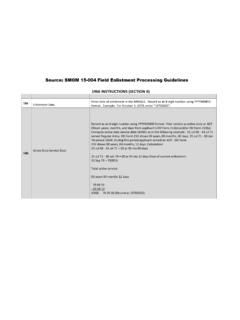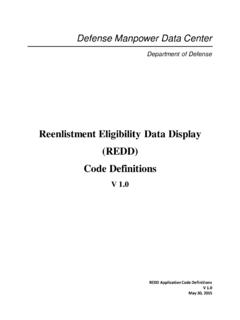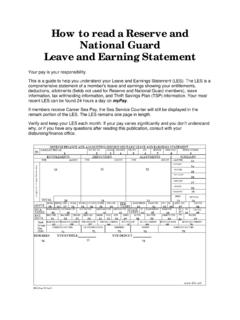Transcription of NEW JERSEY ARMY NATIONAL GUARD …
1 1 NEW JERSEY army NATIONAL GUARD retention handbook Original 1 January 2013 Revised 27 June 2017 2 3 Table of Contents Chapter 1 Introduction Page 1-1 The Adjutant General s Mission Statement 6 1-2 The Attrition/ retention /Strength Management Program 6 1-3 Use of this program 6 1-4 Design of this program 7 1-5 Administrative Instructions 7 Chapter 2 Duties and Responsibilities2-1 Intent of this chapter 8 2-2 Layout of this chapter 8 2-3 Use of this program 9 2-4 Adding Tasks 10 Table 2-1, Task/Owner Matrix 10 Task Break Out 10 Chapter 3 Soldier Sponsorship 3-1 Purpose 22 3-2 NJDMAVA 1315 Series 22 3-3 Duties and Responsibilities 22 3-4 Sponsor Selection Criteria 26 3-5 Duration of the Sponsorship Program 26 3-6 NJDMAVA Form 1315-1 New Enlistment Notification 27 NJARNG Sponsorship Checklist 27 NJDMAVA Form 1315-3 Soldier Responsibility Card 30 NJDMAVA Form 1315-4-R Sponsorship Log 31 Chapter 4 Career Counseling Card 4-1 Intent 32 4-2 Instructions 32 4-3 NJDMAVA Form 1315 interview schedule logic 32 4-4
2 Interview with time frames 32 4-5 Disposition of Card 34 4-6 Responsibility of ADURNCO 34 4-7 Responsibility of Commander 34 4-8 Responsibility of the Recruit Sustainment Program 35 4-9 NJDMAVA Form 1315 36 4 Chapter 5 Attendance Improvement Page 5-1 Intent 37 5-2 Problem Solving 37 5-3 Corrective Action 38 5-4 Disciplinary Action 39 5-5 Duties and Responsibilities 39 5-6 Mandatory Attendance for Education Programs 40 5-7 Figure 5-2 & 5-3 Sample AWOL Letters 41 Chapter 6 retention Tools 6-1 Intent 44 6-2 Appointments 44 6-3 Command Climate Survey 45 6-4 Features and Benefits Binder 46 6-5 retention Council 47 6-6 Award and Incentive Program 47 6-7 Soldier Action Requests 48 6-8 Attendance Improvement Teams 49 6-9 Contents of ADURNCO Tool Box 49 6- 10 Access to retention Management System (RMS).
3 50 6-11 Access to Reserve Component Automated Systems (RCAS)..51 Chapter 7 Training Requirements 7-1 Additional Duty Unit retention NCO Training 52 7-2 Attrition Manager Training for the First Line Leader 53 7-3 Sponsorship Training / Train the Trainer 55 7-4 Sponsorship Training 57 7-5 FTSF retention Training 58 7-6 RRNCO retention Refresher Training 59 Chapter 8 Recruit Sustainment Program 8-1 Mission 61 8-2 RSP Phases and Soldier Readiness Modules (STRM) 61 8-3 RSP Metrics 62 8-4 Battle Hand-Off Procedures 63 Appendices 5 A Acronyms 64 B NJARNG AWOL Recovery Form 69 C Extension Forms 70 D Soldier Action Request 71 6 Chapter 1 Introduction 1-1 The Adjutant General's (TAG) Mission Statement Maintaining Soldier strength is the number one priority of the New JERSEY army NATIONAL GUARD (NJARNG).
4 Unit readiness and preparedness, hence mission accomplishment, are difficult to achieve if units do not maintain appropriate manning levels. First Line Leaders (FLLs) and commanders at every level are responsible for retaining trained Soldiers so the NJARNG can accomplish its assigned state and federal missions. The intent of this document is not to suggest that commanders should coddle Soldiers. In fact, surveys and Strength Management Attrition Model (SMAMs), see Chapter 6, provide clear data on what our first term Soldiers think about the NJARNG and clearly indicate that they joined because they want and enjoy the discipline associated with the armed forces. However, discipline, like that administered to your children, goes hand in hand with caring for the Soldier.
5 To do both successfully requires skill, tools and training. Commanders, FLLs and Full-Time Support Force (FTSF) Soldiers who do not possess the skill, use the tools, or seek the training, have low retention and high attrition rates in their units. This is unacceptable and all leaders are responsible for fixing it. 1-2 The Attrition and retention Management/Strength Management Program (for the rest of this document referred to as "Program") This program is designed to provide unit commanders with explicit tools to accomplish the strength management mission. It is not the only solution. Commanders at all levels must supplement this program with unit specific initiatives and SOPs. Further, the guidance outlined in this program is NJARNG specific. This program does not repeat information provided in other documents.
6 1-3 Use of this program This retention program is broken down into specific chapters. Each chapter is a stand-alone retention system. The intent of each system is fully explained in the chapter itself. However, Chapter 2 is the "meat" of this program. It provides specific tasks for which we have assigned ownership, by duty position, and that the NJARNG chain of command must accomplish. It is in a matrix format. Therefore, every Soldier in an identified duty position must read and keep a copy of this program in their possession or personal library. It is a framework for the continuous application of the day-to-day requirement of caring for our Soldiers and their needs. Chapter 2 also leads task owners (explained in par 2-1) to other chapters (or systems) in this program.
7 7 1-4 Design of this program This program was developed with input from Soldiers representing every Major Subordinate Command (MSC) in the NJARNG. We designed it in a Total Quality Management forum. It is a tool designed by users, for users. It is not a policy subject to selective compliance. This program is designed to fix responsibility for retention tasks on specific individuals instead of stating, "the commander is responsible for everything." This will preclude us from not knowing who is responsible for what as far as retaining our Soldiers is concerned. 1-5 Administrative instructions Use of the pronouns he, him, and his are used throughout this program to prevent having to use he/she or him-his/her. This is not a reflection of any gender bias.
8 In this program, word use such as "will" and "must" means that The Adjutant General is directing that whatever is being discussed is not optional; it is an order. Word use such as "may," "can," "should" and "could" designate portions of the program that are left up to a commander's discretion, though highly encouraged. 8 Chapter 2 Duties and Responsibilities 2-1 Intent of this chapter This chapter identifies mandatory retention tasks. It provides an alphabetical listing of these tasks. The tasks are then broken down into component sub-tasks. Each task or sub-task has an "owner". A NATIONAL GUARD Soldier s duty position designates him as the owner. If a commander does not have a Soldier (owner) in a position listed in this program, the commander is still responsible for completing all tasks.
9 Therefore, all commanders must ensure that they identify an owner for each task and sub-task. If this program does not address a commander's specific situation and needs, he will designate an owner for each listed task and sub-task. The designation of the task owner will be in writing in a unit retention SOP. Commanders may make pen and ink changes directly to this chapter when creating their unit SOP. This will preclude the necessity of commanders having to create their own document. Simply make the changes to this chapter and make it part of the company's specific retention SOP. The intent is to identify owners of specific tasks, not to create more paperwork. However, commanders at all levels can only make changes to those tasks having related owners who are subordinate to them.
10 Commanders will not make changes to tasks for which they have no control. The requirement for completing all of the tasks greatly outweighs the relevance of who is completing them. 2-2 Layout of this chapter a. This chapter is broken down into two parts: Part 1 - The task/owner matrix (Table 2-1): The matrix consists of all mandatory retention tasks shown down the left column of Table 2-1. The owners of all of the tasks are shown in the top row of Table 2-1. The Xs in all corresponding columns and rows identify a role in task ownership. Part 2 - The task and sub-task breakout and the role of the owner: Each retention task consists of sub-tasks. The role of each owner for any task or sub-task is specifically described in this portion of the chapter. b.












